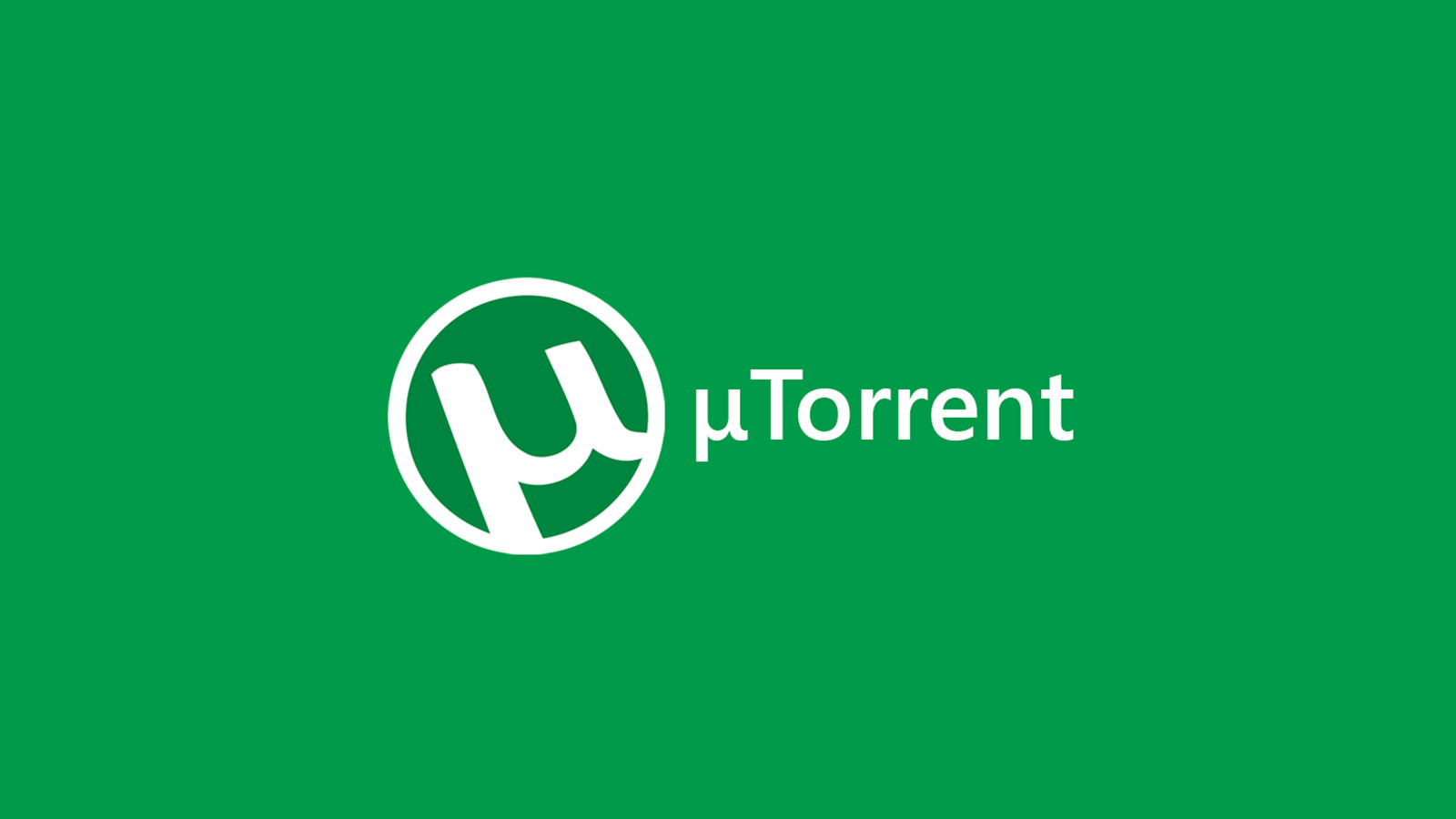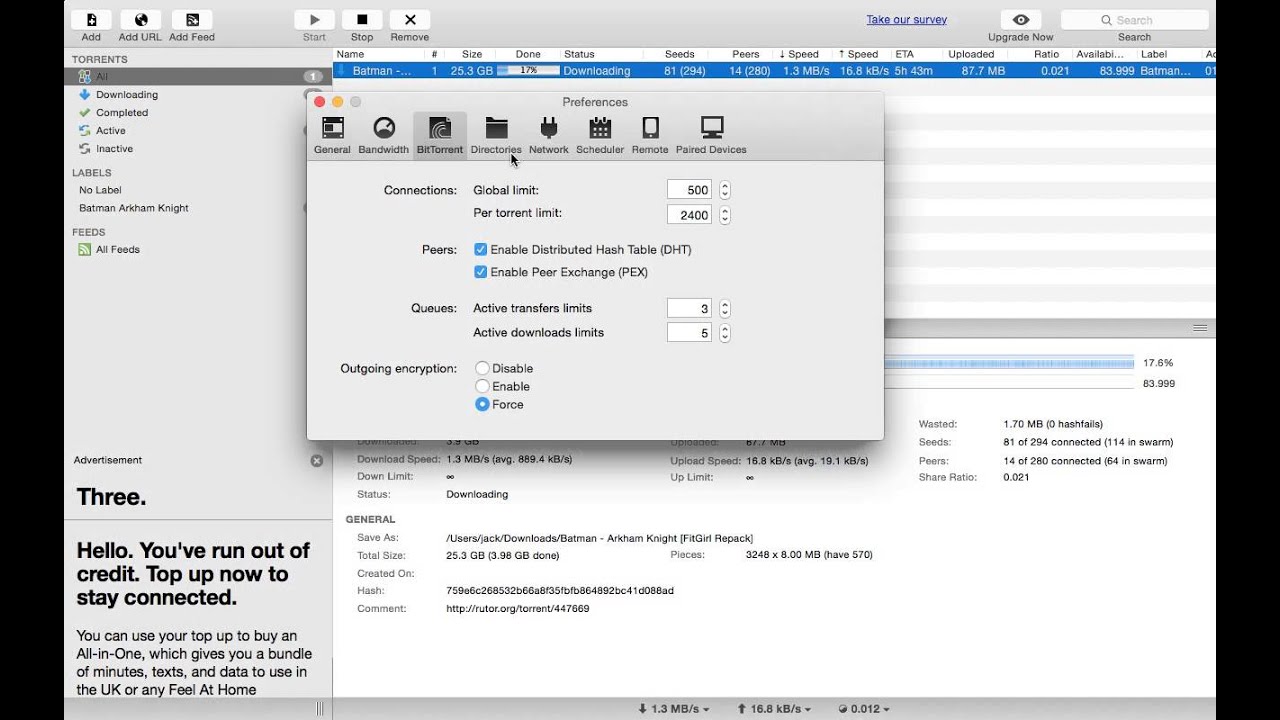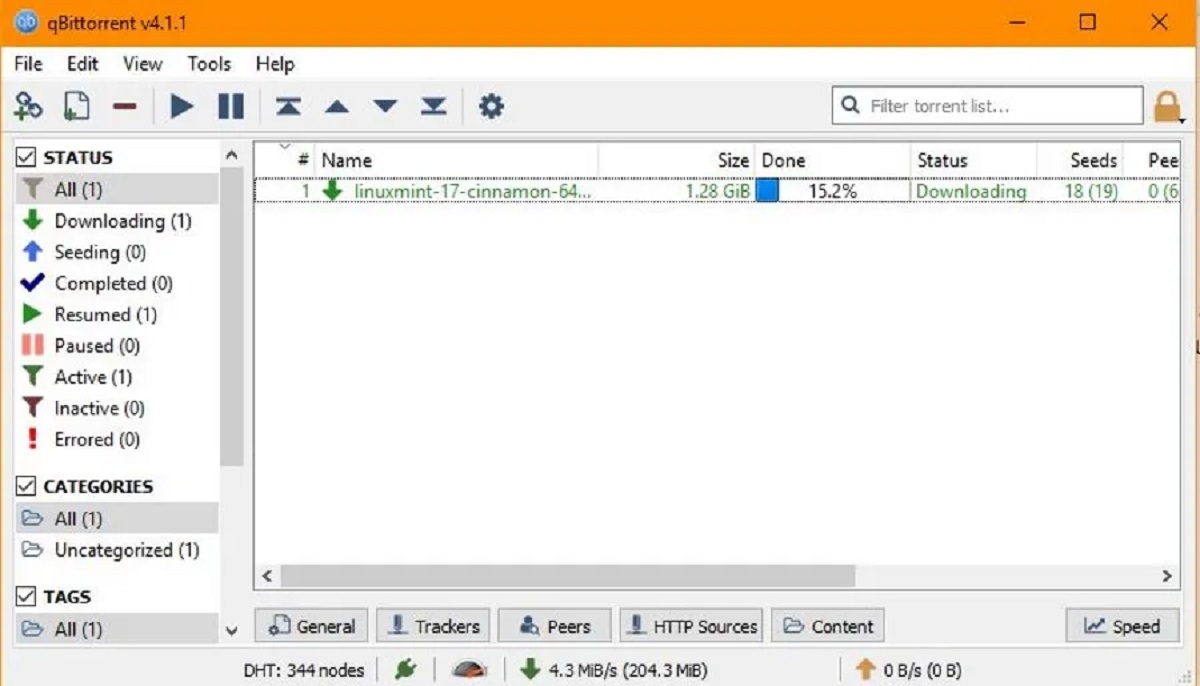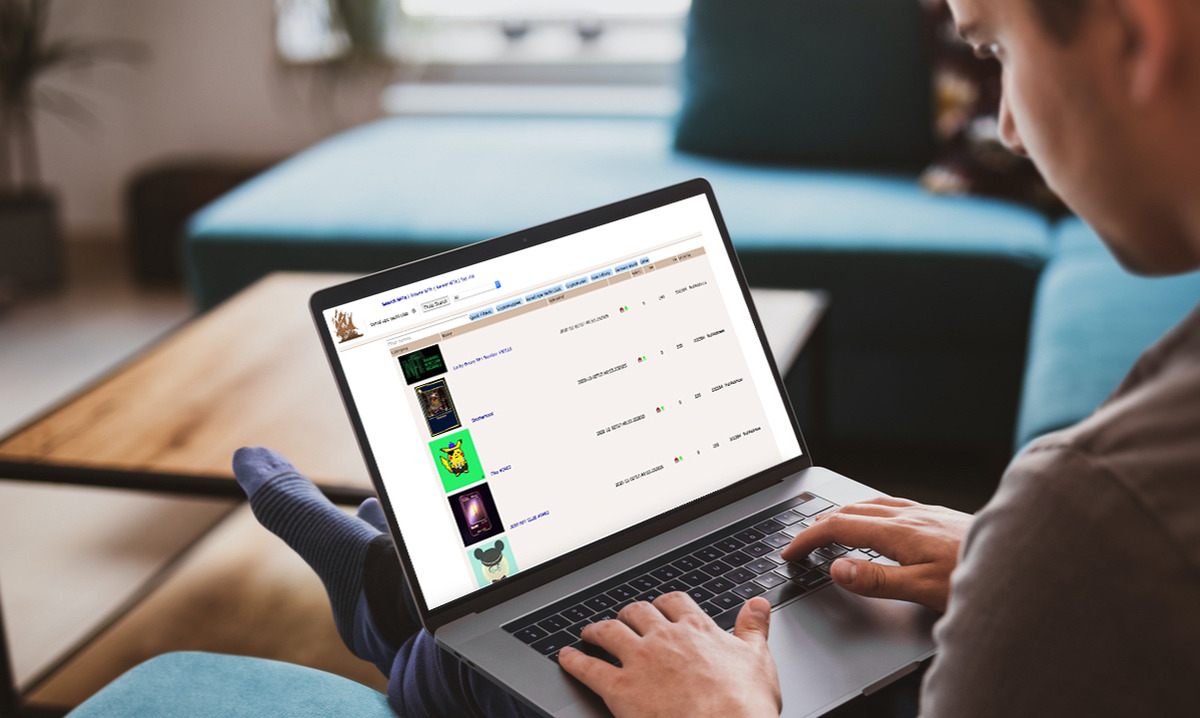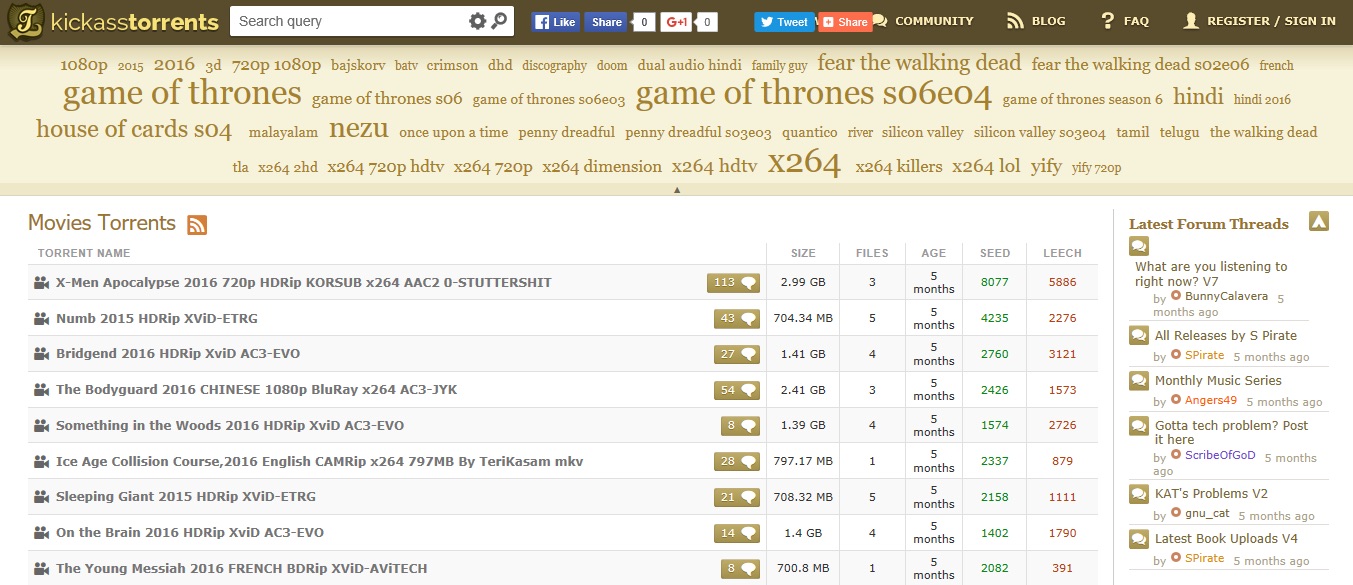Introduction
Torrents have revolutionized the way we download and share files over the internet. They offer a decentralized method of file distribution, enabling users to download files from multiple sources simultaneously. Whether you’re looking for movies, music, software, or books, torrenting allows for faster and more efficient downloads compared to traditional methods. However, optimizing your torrenting experience is crucial to ensure faster download speeds and a smoother overall process.
In this article, we will explore various techniques and strategies to download torrents faster. We will cover everything from choosing the right torrent client to optimizing your internet connection and prioritizing downloads. By implementing these tips, you’ll be able to make the most out of your torrenting experience and enjoy speedy downloads.
Before diving into the details, it’s essential to understand the fundamentals of torrents. Torrents are small files that contain information about the files you want to download and the sources (seeders and leechers) available for the files. Seeders are users who have completed downloading the file and are sharing it, while leechers are users who are actively downloading the file. The more seeders there are, the faster your download speed will be.
With this basic understanding, let’s delve into the various techniques and strategies you can implement to download torrent files faster. From choosing the right torrent client to optimizing your internet connection, we’ve got you covered.
Understanding Torrents
Torrents are a popular method for sharing files over the internet. Rather than relying on a centralized server, torrents use a peer-to-peer (P2P) network where files are distributed among multiple users. This decentralized approach offers numerous benefits, including faster download speeds and increased reliability.
When you download a torrent file, you’re not actually downloading the file itself. Instead, you’re downloading a small file that contains metadata about the desired file, such as its name, size, and a list of trackers. Trackers are servers that facilitate communication between peers and help coordinate the file-sharing process.
Once you have the torrent file, you’ll need a torrent client to initiate the download. A torrent client is a software application that handles the communication with other users in the torrent network. It connects to the trackers and identifies other users, known as seeders and leechers, who are sharing and downloading the file, respectively.
Seeders are users who have already downloaded the entire file and are actively sharing it with others. They play a crucial role in the torrent ecosystem, as they provide the pieces of the file that others need to complete their downloads. The more seeders there are, the faster the download speeds can be.
Leechers, on the other hand, are users who are actively downloading the file. As they retrieve different pieces of the file from various seeders, they also contribute to the overall sharing process by becoming seeders themselves once their download is complete.
The strength of the torrent network lies in its collaborative nature. Everyone who is downloading a particular file is simultaneously contributing to the distribution of that file. This means that as more people join a torrent, the availability and download speed of the file can improve.
It’s worth noting that while torrents offer many benefits, they can also be associated with illegal file sharing. It’s important to respect copyright laws and only download and share files that you have the legal right to access. Furthermore, some ISPs and countries may restrict or monitor torrent activity, so it’s wise to use a VPN (Virtual Private Network) for privacy and security.
Now that you have a basic understanding of how torrents work and the role of seeders and leechers, let’s explore the steps you can take to enhance your torrenting experience and download files faster.
Choosing the Right Torrent Client
When it comes to downloading torrents, the first step is to choose the right torrent client. A torrent client is a software application that allows you to connect to the torrent network, search for files, and download them. There are several torrent clients available, each with its own features and capabilities. Here are a few factors to consider when selecting the right torrent client:
- User Interface: Look for a torrent client with a user-friendly interface that is easy to navigate. A clean and intuitive interface can make the torrenting process more enjoyable and efficient.
- Platform Compatibility: Ensure that the torrent client is compatible with your operating system, whether it’s Windows, macOS, Linux, or mobile platforms like Android or iOS.
- Features: Consider the features offered by the torrent client. Some popular features include the ability to prioritize downloads, manage bandwidth, and schedule downloads for off-peak hours.
- Speed and Performance: Look for a torrent client that offers good download and upload speeds, as well as efficient resource management. Some clients have built-in speed optimization features to improve your overall torrenting experience.
- Community Support: Check if the torrent client has an active and helpful community forum or support channels. This can be valuable if you encounter any issues or have questions regarding the software.
- Security: Consider a torrent client that has built-in security features, such as the ability to scan files for malware or the option to use a VPN for added privacy and anonymity.
Some popular torrent clients to consider include uTorrent, BitTorrent, qBittorrent, Deluge, and Transmission. Take the time to research and try out different clients to find the one that best suits your needs and preferences.
It’s worth mentioning that while uTorrent and BitTorrent are widely used, there are some concerns regarding bundled adware and limited customization options. If you prefer a lightweight and open-source alternative, consider qBittorrent or Deluge, which offer similar functionality without any bundled adware.
Remember, the choice of a torrent client is a personal preference, and what works for others may not work for you. Experiment with different options to find the one that provides the best balance of features, performance, and ease of use. Once you’ve selected a torrent client, you’re ready to move on to the next step: finding reliable torrent sites.
Finding Reliable Torrent Sites
When it comes to downloading torrents, finding reliable torrent sites is essential. These sites act as directories or search engines for torrent files, making it easier for you to discover and download the files you’re interested in. However, not all torrent sites are created equal, and it’s important to choose reputable and trustworthy sites to avoid malware, fake files, or legal issues. Here are some tips for finding reliable torrent sites:
- Do Your Research: Before using a torrent site, take some time to research its reputation. Look for reviews and user feedback to gauge the site’s reliability and safety. It’s also helpful to check if the site has a community or forum where users can discuss and share their experiences.
- Prioritize Popular and Established Sites: Popular torrent sites that have been around for a while tend to have a large user base and a higher chance of hosting legitimate files. Some well-known torrent sites include The Pirate Bay, 1337x, RARBG, and Torrentz2.
- Read Comments and Ratings: When browsing a torrent site, pay attention to user comments and ratings. These can provide valuable insights into the quality and authenticity of the files available for download. Positive comments and high ratings indicate a higher likelihood of finding reliable torrents.
- Use Verified or Trusted Uploaders: Many torrent sites have a system to verify or label trusted uploaders. These uploaders are known for providing high-quality and legitimate files. Prioritizing torrents uploaded by trusted users can increase your chances of finding reliable content.
- Consider Public and Private Torrent Sites: Public torrent sites are accessible to everyone, while private torrent sites require registration and often have stricter rules. Private sites tend to have a more dedicated community, which can lead to higher quality torrents and better download speeds.
- Beware of Malware and Fake Files: Be cautious of torrents that claim to be something they’re not, such as movies or software before their official release dates. Such torrents are more likely to contain malware or fake files. Always read the torrent description and comments to verify its authenticity.
Remember, while torrenting itself is legal, downloading copyrighted content without permission is illegal in many countries. Make sure to respect copyright laws and use torrent sites ethically.
By following these tips, you can increase your chances of finding reliable torrent sites and accessing legitimate files. Once you’ve identified a trustworthy site, it’s time to explore the next steps for optimizing your torrenting experience.
Checking Seeders and Leechers
When downloading torrents, one important factor to consider is the number of seeders and leechers for a particular file. Seeders are users who have completed downloading the file and are actively sharing it, while leechers are users who are currently downloading the file. Checking the number of seeders and leechers is crucial for a faster and reliable download. Here’s why:
Download Speed: The more seeders there are, the faster your download speed will be. Seeders have already downloaded the entire file and are actively sharing it with others. With more seeders, you have more sources from which to download different pieces of the file simultaneously, resulting in a faster overall download speed.
Reliability and Availability: Torrents with a higher number of seeders and a lower number of leechers tend to be more reliable and readily available. If a file has many seeders, it means that there are multiple users actively sharing the file, increasing the chances of successfully completing your download. On the other hand, a high number of leechers can potentially slow down the download process, as there may be more users competing for available bandwidth.
When browsing a torrent site, you’ll often find information about the number of seeders and leechers next to each listed file. This information helps you gauge the popularity and quality of a torrent. It’s generally recommended to choose torrents with a higher number of seeders and a lower number of leechers to maximize download speed and reliability.
However, it’s important to note that the number of seeders and leechers is not the only factor to consider. It’s also crucial to check the comments and ratings for a specific torrent, as they can provide additional insight into the quality and authenticity of the file. Some torrents with fewer seeders may still offer good download speeds if the users sharing the file have fast internet connections.
It’s worth mentioning that as you download a file and become a seeder yourself, you contribute to the torrent ecosystem by sharing the file with others. This not only benefits other users but also helps maintain a healthy torrent community.
By checking the number of seeders and leechers, you can make informed decisions about which torrents to download. Prioritizing torrents with a higher number of seeders ensures faster download speeds and increased reliability. Now that you understand the importance of seeders and leechers, let’s move on to optimizing your internet connection for faster torrent downloads.
Optimizing Your Internet Connection
Having a stable and high-speed internet connection is crucial for faster torrent downloads. By optimizing your internet connection settings, you can enhance your overall torrenting experience. Here are some key tips for optimizing your internet connection:
- Check Your Internet Speed: Before diving into torrenting, it’s important to know your internet speed. Use online speed testing tools to determine your upload and download speeds. This information will help you gauge the expected performance and set realistic expectations for your torrent downloads.
- Choose the Right Internet Plan: If you frequently engage in torrenting or other high-bandwidth activities, consider upgrading to a higher-speed internet plan that meets your needs. Faster internet speeds will result in quicker torrent downloads.
- Connect via Ethernet: For the best possible speeds and stability, connect your computer or device to your router using an Ethernet cable. Wired connections generally provide faster and more reliable speeds compared to Wi-Fi connections.
- Optimize Wi-Fi for Torrenting: If using Wi-Fi, ensure that you’re on a strong, stable network. You can improve your Wi-Fi signal and reduce interference by positioning your router in a central location, away from obstructions, and by using the 5 GHz band if available.
- Limit Background Activities: To maximize your torrent download speed, close or pause any bandwidth-heavy applications or activities running in the background, such as streaming services or large file uploads and downloads.
- Enable Port Forwarding: Port forwarding allows for a direct and uninterrupted connection between your torrent client and the internet. Consult your router’s documentation for instructions on how to enable port forwarding for your specific model.
- Optimize Quality of Service (QoS) Settings: Quality of Service settings help prioritize your torrent traffic over other types of internet traffic. If your router supports QoS, configure it to give priority to torrent traffic for an optimal torrenting experience.
- Use a Wired Connection for Seeding: If you plan to seed (share) files after downloading them, consider connecting your computer or device via Ethernet. This will ensure a stable and consistent upload speed, benefiting other users in the torrent network.
Implementing these tips will help you optimize your internet connection for faster torrent downloads. However, do keep in mind that your download speed is also dependent on the number of seeders, the overall health of the torrent, and the individual upload speeds of the seeders. Now that you have optimized your internet connection, let’s explore bandwidth allocation to further improve your torrenting experience.
Utilizing Bandwidth Allocation
When it comes to downloading torrents, effectively managing your bandwidth allocation is crucial. Bandwidth allocation refers to dividing your available internet speed among the different activities or applications that are using your network connection. By properly allocating your bandwidth, you can prioritize your torrent downloads and ensure faster speeds. Here’s how you can make the most of bandwidth allocation:
- Set Download and Upload Speed Limits: Most torrent clients allow you to set download and upload speed limits. By setting reasonable limits, you can ensure that your torrent downloads don’t overwhelm your connection, allowing for smoother browsing and other online activities.
- Limit Concurrent Torrent Downloads: If you’re downloading multiple torrents simultaneously, consider reducing the number of active downloads. This will allocate more bandwidth to each individual download, potentially improving the overall download speed.
- Prioritize Downloads: Some torrent clients allow you to prioritize specific files or torrents. By assigning a higher priority to files that you want to download first, you can ensure that they receive a larger share of your available bandwidth, speeding up their download process.
- Set Time-Sensitive Schedules: If you experience slow internet speeds during certain hours of the day, you can schedule your torrent client to download files during off-peak hours. This way, you can take advantage of faster speeds when network congestion is lower.
- Enable Seeding Limits: Seeding is crucial for maintaining the health and availability of torrents. However, you can set limits on your upload speed or the ratio at which you seed files. This ensures that your uploads don’t consume all of your available bandwidth, allowing for a better overall torrenting experience.
Experimenting with different bandwidth allocation settings can help you find the optimal balance for your specific internet connection and preferences. It’s important to note that the speed and quality of your torrent downloads can also depend on external factors, such as the number of seeders, their upload speeds, and the overall health of the torrent.
By utilizing bandwidth allocation effectively, you can make the most out of your internet connection and ensure faster and more efficient torrent downloads. Now that you understand bandwidth allocation, let’s explore other strategies to further optimize your torrenting experience.
Adjusting Upload and Download Limits
When it comes to downloading torrents, adjusting your upload and download limits can significantly impact your overall torrenting experience. By properly managing these limits, you can optimize your download speeds and ensure a smoother sharing process. Here are some tips for adjusting your upload and download limits:
- Upload Speed Limit: Set a reasonable upload speed limit in your torrent client. When you share files with other users (seeders), it consumes a portion of your available upload bandwidth. By limiting your upload speed, you can allocate more bandwidth for downloading, resulting in faster download speeds.
- Download Speed Limit: Similarly, set a download speed limit to moderate how much bandwidth your torrent client utilizes for downloading files. This ensures that your internet connection remains stable and other online activities are not affected by the torrent downloads consuming all available bandwidth.
- Consider a Balanced Approach: Striking a balance between upload and download limits is important. If you completely throttle your uploads, it may negatively impact your download speed, as many torrent clients rely on reciprocal sharing for faster downloads. Experiment with different upload and download limits to find the best compromise that suits your needs.
- Adjust Limits Based on Connection Type: If you have a limited or slower internet connection, it may be beneficial to lower both upload and download limits to ensure a stable and consistent connection. On the other hand, if you have a high-speed connection, you can increase the limits to take advantage of the additional bandwidth.
- Monitor Overall Network Usage: Keep an eye on your network usage while downloading torrents. If you notice that your torrent downloads are slowing down other online activities, consider reducing the upload and/or download limits to alleviate the strain on your internet connection.
- Limit Seeding Ratio: Most torrent clients allow you to set a seeding ratio, which determines when the client stops uploading a file after reaching a certain ratio (e.g., 1.0). By adjusting this ratio, you can manage how much you contribute to the torrent network’s overall sharing process.
Keep in mind that torrenting is a collaborative process, and maintaining a good upload-to-download ratio helps sustain the health of the torrent ecosystem. However, finding the right balance between upload and download limits is crucial for optimizing your overall torrenting experience.
Experiment with different upload and download limits to gauge the impact they have on your download speeds and overall internet connectivity. Remember, finding the optimal settings may require some trial and error, as it depends on various factors such as your internet speed, the number of seeders, and the health of the torrent.
By adjusting your upload and download limits effectively, you can prioritize your bandwidth usage and ensure faster and more efficient torrent downloads. Now that you understand how to adjust these limits, let’s explore strategies for prioritizing the right files to download first.
Prioritizing the Right Files to Download First
When downloading torrents that contain multiple files, it’s important to prioritize the right files to download first. This ensures that you can access the most important or desired content as quickly as possible. By understanding how to prioritize files, you can optimize your torrenting experience. Here are some strategies for prioritizing the right files to download first:
- Identify Important Files: Take a closer look at the files within a torrent and determine which ones are the most crucial or relevant to you. For example, if the torrent contains a music album, you may want to prioritize downloading your favorite songs first.
- Check File Size: Consider the file sizes within the torrent. If there are significantly larger files, they may take longer to download, so it’s wise to prioritize them to allow for more time to complete the download.
- Review File Availability: Check the availability of files within the torrent. If certain files have more seeders or higher availability, it indicates a higher chance of successful and faster downloads. Prioritize those files to capitalize on the available resources.
- Utilize Selective Downloading: Some torrent clients offer selective downloading, allowing you to choose specific files or folders within a torrent to download. This feature is useful if you only need certain files and want to skip others, saving you time and bandwidth.
- Consider Your Suitable Viewing/Listening Order: If you’re downloading files like TV shows, movies, or music albums that have a specific viewing or listening order, prioritize downloading them accordingly. This way, you can enjoy the content in the intended sequence without having to wait for the entire torrent to complete.
- Monitor Download Progress: Keep an eye on the download progress for the files you’re prioritizing. Once they are completed, you can start enjoying that content while other files continue to download in the background.
Prioritizing the right files to download first allows you to access the content you’re most interested in sooner, enhancing your torrenting experience. By focusing on important files, you can avoid feeling overwhelmed by large torrents and make the most efficient use of your bandwidth.
Remember, the availability and download speed of files can vary depending on factors such as the number of seeders and leechers, as well as the health of the torrent. Be aware that prioritizing files does not guarantee faster download speeds, as some files may have fewer seeders or lower availability.
By carefully selecting and prioritizing files within a torrent, you can customize your download experience and ensure that you’re accessing the content that matters most to you. Now that you understand how to prioritize files, let’s explore the importance of avoiding media playback during downloading.
Avoiding Media Playback During Downloading
When engaging in torrenting, it is advisable to avoid media playback, such as streaming or watching downloaded content, while the files are still downloading. While it may be tempting to start enjoying the content right away, media playback during downloading can have several negative consequences. Here are the reasons why you should avoid media playback during the downloading process:
- Bandwidth Allocation: When you stream or play media while downloading torrents, it consumes a significant portion of your internet bandwidth. This diverts the available bandwidth away from the downloading process, resulting in slower download speeds and potentially causing interruptions or buffering in your media playback.
- Impact on Speed and Quality: Media playback activities require a stable and consistent internet connection to ensure smooth streaming. However, simultaneous torrent downloads can cause fluctuations in your internet connection, leading to a degraded streaming experience with buffering, pixelation, or decreased video/audio quality.
- Network Congestion: Torrenting itself can put a strain on your network connection due to the nature of P2P file sharing. By engaging in media playback while downloading, you further congest the network, potentially affecting not only your own experience but also the experience of other users on the same network.
- Incomplete Files: While torrent files download in small pieces, attempting to play partially downloaded media files may result in incomplete playback. This can occur if the downloaded pieces crucial for smooth playback have not yet been retrieved. Waiting for the entire file to download before playback ensures a seamless viewing experience.
- File Corruption: Interrupting the downloading process by playing media files can lead to file corruption. If the torrent client is accessing certain parts of a file that you attempt to play, it can cause invalid file states and potentially corrupt the downloaded content. This may result in unusable or unstable media files.
By avoiding media playback during the downloading process, you allow your torrent client to efficiently utilize your available bandwidth and ensure faster and uninterrupted download speeds. Once the torrent is fully downloaded, you can enjoy the media playback without any interruptions or compromises in quality.
Remember, torrenting is an ongoing process, and the complete and uninterrupted download of files should take precedence over immediate media consumption. Allocating your full bandwidth to the downloading process will result in faster and more reliable downloads, enhancing your overall torrenting experience.
Now that you understand the importance of avoiding media playback during downloading, let’s explore how altering protocol encryption settings can further optimize your torrenting activities.
Altering Protocol Encryption Settings
Altering the protocol encryption settings of your torrent client can enhance the privacy, security, and overall performance of your torrenting activities. Encryption helps to prevent your internet service provider (ISP), as well as other third parties, from monitoring or throttling your torrent traffic. By adjusting the encryption settings, you can take control of your privacy and optimize your torrenting experience. Here’s what you need to know about altering protocol encryption settings:
- Protocol Encryption: Most modern torrent clients support protocol encryption, which ensures that your torrent activity is encrypted and cannot be easily identified or monitored. There are two types of encryption: “Enabled” and “Forced”.
- Enabled Encryption: Enabling encryption allows your torrent client to negotiate encrypted connections with other peers. It provides an additional layer of anonymity and security. However, it does not guarantee that all your connections will be encrypted. Some older or poorly configured peers may still use unencrypted connections.
- Forced Encryption: By selecting the “Force” option in your torrent client, you can enforce encrypted connections exclusively. Your torrent client will only connect to peers who support encryption. This ensures that all your torrent traffic is encrypted, providing maximum privacy and security.
- Bypassing ISP Throttling: Some ISPs throttle or limit torrent traffic, leading to slower download speeds. By enabling or forcing encryption, you can potentially bypass such restrictions, making it more challenging for your ISP to detect and interfere with your torrenting activities. This can result in faster and more consistent download speeds.
- Compatibility and Speed Impact: It’s important to note that forcing encryption may limit the number of available peers to connect with, as not all peers support encryption. This can potentially impact the overall download speed or availability of sources. Experiment with encryption settings to find the right balance between privacy and speed.
- VPN Considerations: While protocol encryption can provide an additional layer of privacy, it is still advisable to use a virtual private network (VPN) for maximum security. A VPN encrypts all your internet traffic, including torrenting, and masks your IP address, providing enhanced privacy and anonymity.
It’s important to keep in mind that altering protocol encryption settings can have varying impacts depending on the specific torrent client and network conditions. Experiment with different encryption settings to find the best combination of privacy, speed, and compatibility for your needs.
By adjusting the protocol encryption settings in your torrent client, you can enhance privacy and security while also potentially improving your download speeds and overall torrenting experience. Now that you understand the benefits of altering protocol encryption settings, let’s explore trimming unnecessary plugins and add-ons.
Trimming Unnecessary Plugins and Add-ons
When it comes to optimizing your torrenting experience, it’s important to trim unnecessary plugins and add-ons from your torrent client. Plugins and add-ons can sometimes consume system resources, slow down your client, or introduce potential security vulnerabilities. By streamlining your client’s functionality, you can improve performance and reduce potential issues. Here are some reasons to consider trimming unnecessary plugins and add-ons:
- Improved Performance: Unnecessary plugins and add-ons can contribute to a bloated torrent client, which may result in sluggish performance. By removing or disabling unused extensions, you can streamline the client’s operations and potentially improve overall performance and responsiveness.
- Increased Stability: Some plugins or add-ons might not be fully compatible with your torrent client or have unintended side effects. These can cause crashes, freezes, or other stability issues. Removing unnecessary plugins reduces the chances of encountering such problems and improves the stability of your client.
- Reduced Resource Consumption: Plugins and add-ons often utilize system resources, such as memory or processing power, even when not actively in use. By eliminating unnecessary extensions, you can free up these resources for other tasks, allowing your torrent client to perform more efficiently.
- Enhanced Security: Outdated or insecure plugins can pose a security risk, potentially exposing your system to vulnerabilities. By regularly reviewing and removing unnecessary extensions, you reduce the potential attack surface and mitigate potential security threats.
- Simplified User Interface: Having an overload of plugins and add-ons can clutter the user interface of your torrent client, making it difficult to navigate and find essential features. Trimming unnecessary extensions can help streamline the user interface and enhance the overall user experience.
To trim unnecessary plugins and add-ons, review the installed extensions within your torrent client and evaluate their usefulness. Remove any that you no longer require or that serve limited practical value. However, exercise caution when removing plugins, as some may be essential for certain functionalities or integrations that you rely on.
Regularly reviewing and keeping your torrent client lean and efficient not only optimizes its performance but also minimizes potential security risks. It’s good practice to periodically reassess your plugin and add-on selection to ensure that you’re utilizing only the necessary and beneficial extensions.
Now that you understand the benefits of trimming unnecessary plugins and add-ons, let’s explore how you can make use of proxy servers or virtual private networks (VPNs) to enhance your torrenting experience.
Making Use of Proxy Servers or VPNs
When it comes to torrenting, utilizing proxy servers or virtual private networks (VPNs) can provide an added layer of security, privacy, and anonymity. Proxy servers and VPNs help to mask your IP address, encrypt your internet traffic, and protect your online activities from prying eyes. Here’s how you can make use of proxy servers or VPNs to enhance your torrenting experience:
- Privacy and Anonymity: Proxy servers and VPNs hide your true IP address, making it difficult for others to trace your online activities back to your location or identity. This helps to safeguard your privacy and anonymity while engaging in torrenting.
- Bypassing Geo-Restrictions: Many torrent sites and trackers may be blocked or restricted in certain regions. By connecting to a proxy server or VPN located in a different country, you can bypass these geo-restrictions and gain access to a wider range of torrents.
- Encryption of Traffic: Proxy servers and VPNs encrypt your internet traffic, including your torrent downloads. This ensures that your ISP or any potential eavesdroppers cannot monitor or intercept your torrenting activity, providing an additional layer of security.
- Protection from Throttling: Some ISPs may throttle or limit the bandwidth allocated to torrent traffic. By using a proxy server or VPN, you can circumvent this throttling and maintain consistent download speeds, as your ISP won’t be able to detect and target your torrenting activities.
- Choose Reliable Proxy Servers or VPNs: When selecting a proxy server or VPN provider, ensure that they have a good reputation for privacy, security, and reliable performance. Look for providers that offer robust encryption, a wide range of server locations, and a strict no-logs policy to protect your data and privacy.
- Set Up Proxy or VPN in Your Torrent Client: Once you have a proxy or VPN service in place, configure your torrent client to use the proxy or VPN connection. Follow the instructions provided by your proxy or VPN provider to properly set up the client and ensure that your torrent traffic is routed through the proxy or VPN server.
It’s important to note that while proxy servers and VPNs offer privacy and security benefits, they do not grant you immunity from illegal activities. It is crucial to use legal sources and adhere to copyright laws when engaging in torrenting.
By making use of proxy servers or VPNs, you can enhance your torrenting experience by ensuring your privacy, bypassing restrictions, and protecting your online activities. However, it’s important to choose a reputable and trustworthy proxy or VPN provider to ensure the highest level of security and performance.
Now that you understand the advantages of using proxy servers or VPNs for torrenting, let’s explore the importance of regularly checking for software or firmware updates.
Checking for Software or Firmware Updates
Regularly checking for software or firmware updates for your torrent client and any relevant devices is an important practice for optimizing your torrenting experience. Updates often include bug fixes, performance improvements, and security patches that can enhance the stability, speed, and security of your torrenting activities. Here are the reasons why you should prioritize software and firmware updates:
- Bug Fixes and Performance Improvements: Software and firmware updates usually address known issues and bugs in the current version. By keeping your torrent client, operating system, and devices up to date, you can benefit from enhanced performance, reduced crashes, and a smoother overall torrenting experience.
- Security Enhancements: Updates often contain crucial security patches that protect you from vulnerabilities and potential threats. Cybersecurity is of utmost importance, especially in the torrenting world where malicious actors may exploit security loopholes. Staying up to date with updates reduces the risk of malware, unauthorized access, and data breaches.
- Compatibility with New Features: Software and firmware updates may introduce new features or improvements that enhance the torrenting experience. By keeping your client and devices updated, you can take advantage of these new features and benefit from any performance or usability enhancements they offer.
- Improved Stability and Reliability: Updates often address software or hardware issues that may impact the stability of your torrent client or devices. These updates can help prevent crashes, freezes, or other reliability issues that could disrupt your torrenting activities.
- Patch Vulnerabilities: Torrent clients and other torrent-related software are not immune to vulnerabilities. Regular updates ensure that any known vulnerabilities are patched, reducing the chances of being exploited by hackers or malware.
To ensure that your torrent client and devices are up to date, it’s recommended to enable automatic updates whenever possible. This way, you can be confident that you’re benefiting from the latest enhancements and security patches without having to manually check for updates. However, it’s also advisable to periodically review and manually check for updates, as some updates may require manual confirmation or settings adjustments.
Update checks should extend beyond your torrent client to include any operating systems, drivers, or firmware for the devices connected to your torrenting activities. By ensuring that all components are up to date, you minimize potential compatibility issues and maximize the efficiency and security of your torrenting setup.
By regularly checking for software or firmware updates, you can keep your torrent client and devices in optimal condition, benefiting from performance improvements, security enhancements, and stability. Now that you understand the importance of updates, let’s move on to verifying file integrity.
Verifying File Integrity
Verifying the integrity of downloaded torrent files is an essential step in ensuring that the files you have obtained are complete and free from errors. File integrity checks help you identify any issues or corruptions that may have occurred during the download process. By verifying the integrity of your downloaded files, you can guarantee that they are authentic and can be trusted. Here’s why it’s important to verify file integrity:
- Detecting Download Errors: During the torrent download process, errors may occur due to various factors such as unstable internet connections or faulty sources. Verifying file integrity allows you to identify and resolve any download errors, ensuring that you have a complete and accurate file.
- Preventing Corrupted Files: Corrupted files can occur when data within the file becomes damaged or incomplete. Verifying the integrity of downloaded files allows you to identify and discard any corrupted files, reducing the risk of encountering issues when using the file.
- Ensuring Authenticity: Verifying file integrity ensures that the downloaded file matches the original file shared by the seeder. It provides assurance that the file has not been tampered with or modified, particularly important for sensitive data or files obtained from untrusted sources.
- Using Hash Checksums: One common method to verify file integrity is through the use of hash checksums. Hash checksums are unique alphanumeric strings generated based on the contents of a file. Comparing the checksum of the downloaded file with the provided checksum ensures that the file has not been altered.
- Using Torrent Hashes or Magnet Links: Another way to ensure file integrity is by comparing the torrent hash or magnet link with the one provided by the trusted source. This confirms that the downloaded file matches the original file’s identifier and guarantees its integrity.
Most popular torrent clients offer built-in features to verify file integrity using hash checksums. These features calculate the checksum of the downloaded file and compare it with the expected checksum. If the checksums match, it means the file is intact and has not been modified. If they don’t match, it indicates that the file is corrupted or has been tampered with.
Verifying file integrity should be a standard practice after every torrent download, especially for files that contain valuable or sensitive data. It’s a proactive measure to ensure that you have received the complete and unaltered file that you intended to download.
By verifying file integrity, you can confidently use and rely on the downloaded files, knowing that they are authentic and error-free. Now that you understand the importance of verifying file integrity, let’s explore how seeking help from torrent communities can further enhance your torrenting experience.
Seeking Help from Torrent Communities
Torrent communities play a crucial role in providing support, guidance, and valuable resources to individuals engaging in torrenting activities. These communities offer a wealth of knowledge, forums, and platforms where users can seek assistance, share experiences, and find solutions to common issues. Here’s why seeking help from torrent communities can enhance your torrenting experience:
- Valuable Expertise: Torrent communities are filled with experienced individuals who possess a wealth of knowledge about torrenting. They can provide guidance on various aspects, such as choosing the right torrent client, finding reliable torrent sites, troubleshooting common errors, and optimizing the settings for faster downloads.
- Troubleshooting Support: If you encounter any issues or errors during the torrenting process, torrent communities offer a platform to seek help and find solutions. Community members often share step-by-step troubleshooting guides, answer questions, and provide insights based on their own experiences.
- Recommendations and Suggestions: Torrent communities are an excellent source for recommendations on reliable torrent sites, trusted uploaders, and high-quality files. By leveraging the collective knowledge of the community, you can identify the best sources for the files you are interested in and avoid potentially low-quality or fraudulent downloads.
- Sharing Insights and Tips: Members of torrent communities often share their insights, tips, and strategies for maximizing torrenting efficiency and safety. These can range from optimizing upload settings, maintaining good seed-to-leech ratios, or managing download queues effectively.
- Discovering New Content: Torrent communities provide a platform for users to share their discoveries, recommendations, and trends in various categories, such as movies, music, games, or software. By actively participating in the community, you can explore and discover new content that aligns with your interests.
- Discussing Legal Matters: Torrent communities are also a space to discuss legal aspects of torrenting, including understanding copyright laws, sharing information on public domain content, or discussing licensing and fair use. Engaging in these discussions helps promote responsible torrenting practices within the community.
When seeking help from torrent communities, it’s essential to respect the guidelines and rules of the community, adhere to copyright laws, and engage in conversations with a positive and constructive mindset. Remember to be mindful of the privacy and anonymity of fellow community members by avoiding sharing personal information or engaging in illegal activities.
Overall, torrent communities serve as valuable resources for individuals involved in torrenting. By actively participating and seeking help from these communities, you can enhance your torrenting experience, overcome challenges, and stay informed about emerging trends and best practices.
Now that you understand the benefits of seeking help from torrent communities, you have an additional tool to maximize your torrenting experience. Let’s conclude by summarizing the key insights we’ve covered throughout this article.
Conclusion
Torrenting offers a convenient and efficient way to download files, but optimizing your torrenting experience requires a combination of technical considerations and best practices. In this article, we explored various strategies to help you download torrents faster and more effectively.
We began by understanding the basics of torrents, including the role of seeders and leechers in the download process. We then discussed the importance of choosing the right torrent client and finding reliable torrent sites. Checking the number of seeders and leechers, as well as adjusting your internet connection settings and bandwidth allocation, were highlighted as crucial steps to improve download speeds.
We emphasized the importance of prioritizing the right files to download first, avoiding media playback during downloading, and altering protocol encryption settings to enhance privacy and security. Additionally, we discussed the benefits of trimming unnecessary plugins and add-ons and using proxy servers or VPNs to protect your privacy and maintain anonymity.
We also emphasized the significance of checking for software or firmware updates to ensure optimal performance and security. Verifying file integrity and seeking assistance from torrent communities were addressed as essential aspects of a successful torrenting experience.
By implementing the strategies and best practices outlined in this article, you can optimize your torrenting experience, enhance download speeds, protect your privacy, and stay up to date with the latest advancements in the torrenting world.
Remember, while torrenting itself is legal, downloading copyrighted content without permission is illegal in many jurisdictions. Always respect copyright laws and use torrent sites responsibly. Engage in discussions within torrent communities with a positive and collaborative mindset, sharing knowledge, and learning from others.
Now that you have a better understanding of how to download torrents faster and more effectively, it’s time to apply these insights and enjoy a seamless and efficient torrenting experience!










